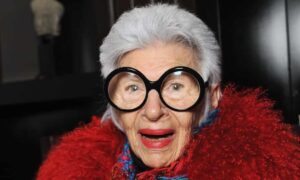
Where to begin. The lessons in how to dress, or the lessons in how to live? Iris Apfel’s 102 years were a masterclass in both.
Really, of course, there’s no debate. We start with the clothes, because the clothes are entirely unignorable. Not so much outfits, as living tableaux. A coat of gold-tipped duck feathers topped with a lei of turquoise pebbles at the neck. Embroidered Indian silk tunics with fringed suede trousers. Fuchsia satin boots and a banana-yellow tulle cape. Bangles stacked to the elbow, a slash of lipstick bright as apricot jam, those delicate, bird-like knuckles dusted with a clatter of sweetie-toned cocktail rings.
Every day, Apfel left the house dressed as a picture of joy. “Life is grey and dull,” she says, in her deliciously chewy New York accent, in Albert Maysles’ 2014 documentary about her life. “You might as well have a little fun dressing up.”
But despite the rainbow pandemonium of her wardrobe and the cacophony of the egg-sized nuggets of souk-bought gems that rattled as she walked, there was a purity to her. She had incredible taste, but no snobbery. She once explained that her passion for accessorising came from her mother, who taught her that “if you bought, for example, a simple little black dress, by changing the accessories, which are so transformative, you could make dozens of outfits out of the same basic piece.”
Apfel wore Dior haute couture with flea-market jewellery, layered a vintage Balenciaga coat over a Mickey Mouse T-shirt, mixed 19th-century ecclesiastical vestments with Topshop.
As a designer and consultant she worked for H&M and for the White House – Mrs Nixon, apparently, was “lovely” – for Faye Dunaway and for Tommy Hilfiger. Her passion for beauty was democratic. Status, price tags, money – these were never the point. The pleasure came from joy. In a 2010 interview with the Observer, she explained that the first painting she ever bought, still hanging in her hallway, is probably by Velasquez, but that she had never had it authenticated, because if it really was she might be nervous to leave it hanging there, and what would be the point in that, since she wouldn’t enjoy it? Apfel didn’t dress like anyone else, because she didn’t think like anyone else. She was a true original.
